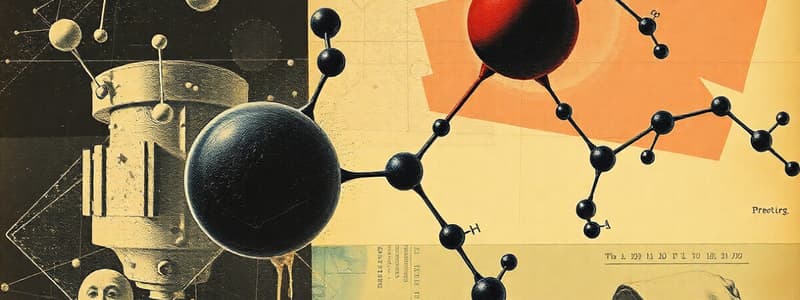Podcast
Questions and Answers
How does the number of protons distinguish one element from another?
How does the number of protons distinguish one element from another?
- The number of protons only affects the charge of the atom, not its identity.
- The number of protons defines the atomic number, uniquely identifying an element. (correct)
- The number of protons affects the mass number but not the elemental identity.
- Different numbers of protons create isotopes of the same element.
Which statement accurately describes the relationship between valence electrons and an atom's chemical properties?
Which statement accurately describes the relationship between valence electrons and an atom's chemical properties?
- The number of valence electrons determines exclusively the mass of an atom.
- Valence electrons only affect physical properties such as conductivity.
- Valence electrons have no impact on an atom's chemical properties; only the total number of electrons matters.
- Valence electrons determine the reactivity and bonding behavior of an atom. (correct)
What is the key distinction between a molecule and a compound?
What is the key distinction between a molecule and a compound?
- A molecule is always made of different elements, whereas a compound is made of the same element.
- A molecule is a group of atoms bonded together, while a compound is a substance with two or more elements chemically bonded in a fixed ratio. (correct)
- A molecule consists of atoms bonded together, while a compound consists of elements physically mixed.
- A molecule is formed by the sharing of electrons, and a compound is formed by the transfer of electrons.
How do ionic and covalent compounds differ in terms of electron interaction?
How do ionic and covalent compounds differ in terms of electron interaction?
What is the significance of balancing chemical equations?
What is the significance of balancing chemical equations?
In an endothermic reaction, how does the energy content of the reactants compare to that of the products?
In an endothermic reaction, how does the energy content of the reactants compare to that of the products?
Which of the following best describes the role of a catalyst in a chemical reaction?
Which of the following best describes the role of a catalyst in a chemical reaction?
How does increasing the concentration of reactants typically affect the rate of a chemical reaction, and why?
How does increasing the concentration of reactants typically affect the rate of a chemical reaction, and why?
Which statement is correct regarding isotopes of the same element?
Which statement is correct regarding isotopes of the same element?
Why do elements in the same group (vertical column) of the periodic table exhibit similar chemical properties?
Why do elements in the same group (vertical column) of the periodic table exhibit similar chemical properties?
How does the total number of protons and neutrons relate to the mass number of an atom?
How does the total number of protons and neutrons relate to the mass number of an atom?
What distinguishes metals from nonmetals in terms of their ability to conduct electricity?
What distinguishes metals from nonmetals in terms of their ability to conduct electricity?
Which of the following is the best description of a metalloid?
Which of the following is the best description of a metalloid?
What happens to chemical bonds during a chemical reaction?
What happens to chemical bonds during a chemical reaction?
Why is activation energy necessary for a chemical reaction to occur?
Why is activation energy necessary for a chemical reaction to occur?
Which of the following factors does NOT typically affect the rate of a chemical reaction?
Which of the following factors does NOT typically affect the rate of a chemical reaction?
How does increasing the temperature usually impact the rate of a chemical reaction?
How does increasing the temperature usually impact the rate of a chemical reaction?
What is the key difference between exothermic and endothermic chemical reactions concerning energy?
What is the key difference between exothermic and endothermic chemical reactions concerning energy?
Which of the following statements is true regarding the electrical charge of an atom?
Which of the following statements is true regarding the electrical charge of an atom?
What is the chemical formula and its significance?
What is the chemical formula and its significance?
What are intermolecular forces and how do they impact the properties of molecules?
What are intermolecular forces and how do they impact the properties of molecules?
How does the nature of bonds affect the formation of ionic versus covalent compounds?
How does the nature of bonds affect the formation of ionic versus covalent compounds?
Which aspect of a substance dictates whether it is classified as an element?
Which aspect of a substance dictates whether it is classified as an element?
How are chemical reactions represented using chemical formulas and symbols?
How are chemical reactions represented using chemical formulas and symbols?
What is the impact of increased surface area of solid reactants on reaction rates?
What is the impact of increased surface area of solid reactants on reaction rates?
How does the 'Law of Conservation of Mass' influence the balancing of chemical reaction equations?
How does the 'Law of Conservation of Mass' influence the balancing of chemical reaction equations?
When considering factors that affect reaction rates, how might the presence of a catalyst influence the process at a molecular level?
When considering factors that affect reaction rates, how might the presence of a catalyst influence the process at a molecular level?
In what way do cations and anions contribute to the formation of ionic compounds?
In what way do cations and anions contribute to the formation of ionic compounds?
How do metalloids uniquely contribute to technological advancements, distinguishing them from typical metals and nonmetals?
How do metalloids uniquely contribute to technological advancements, distinguishing them from typical metals and nonmetals?
Flashcards
Chemistry
Chemistry
The study of matter and its properties, and how matter changes.
Atom
Atom
Basic building blocks of all matter; the smallest particle of an element.
Proton
Proton
Positively charged particles in the atom's nucleus.
Electron
Electron
Signup and view all the flashcards
Neutron
Neutron
Signup and view all the flashcards
Atomic Number
Atomic Number
Signup and view all the flashcards
Isotopes
Isotopes
Signup and view all the flashcards
Mass Number
Mass Number
Signup and view all the flashcards
Valence Shell
Valence Shell
Signup and view all the flashcards
Valence Electrons
Valence Electrons
Signup and view all the flashcards
Molecule
Molecule
Signup and view all the flashcards
Chemical Formula
Chemical Formula
Signup and view all the flashcards
Intermolecular Forces
Intermolecular Forces
Signup and view all the flashcards
Element
Element
Signup and view all the flashcards
Periodic Table
Periodic Table
Signup and view all the flashcards
Metalloids
Metalloids
Signup and view all the flashcards
Compound
Compound
Signup and view all the flashcards
Ionic Compound
Ionic Compound
Signup and view all the flashcards
Ions
Ions
Signup and view all the flashcards
Cations
Cations
Signup and view all the flashcards
Anions
Anions
Signup and view all the flashcards
Covalent Compound
Covalent Compound
Signup and view all the flashcards
Chemical Reaction
Chemical Reaction
Signup and view all the flashcards
Chemical Equation
Chemical Equation
Signup and view all the flashcards
Conservation of Mass
Conservation of Mass
Signup and view all the flashcards
Exothermic reaction
Exothermic reaction
Signup and view all the flashcards
Endothermic reaction
Endothermic reaction
Signup and view all the flashcards
Activation Energy
Activation Energy
Signup and view all the flashcards
Catalysts
Catalysts
Signup and view all the flashcards
Study Notes
- Chemistry is the study of matter, its properties, and how it changes.
Atoms
- The basic building blocks of all matter are atoms
- Atoms are the smallest particle of an element
- Atoms are composed of protons, neutrons, and electrons.
- Protons possess a positive charge
- Electrons possess a negative charge
- Neutrons possess no charge
- The number of protons defines the element
- Isotopes are atoms of the same element with differing neutron counts
- Atomic number defines the number of protons
- Protons and neutrons combined, dictate an atom's mass number.
- Atoms are neutral, having equal proton and electron counts
- Electrons are arranged in energy levels or shells around the nucleus.
- Valence shell: the outermost shell
- Valence electrons: electrons in the outermost shell.
- Valence electrons dictate an atom's chemical properties.
- Atoms bond to form molecules or compounds
Molecules
- Molecules consist of two or more atoms bonded by chemical bonds.
- Molecules can comprise identical elements (e.g., O₂) or varying elements (e.g., H₂O).
- Chemical formulas denote the quantity and type of atoms present (e.g. H₂O = 2 hydrogen atoms and 1 oxygen atom).
- A molecule's shape influences its properties.
- Intermolecular forces act as attractions between molecules.
Elements
- Elements are pure substances of atoms with identical proton numbers
- Elements cannot be chemically broken down
- The periodic table organizes elements by atomic number.
- Elements in the same group share similar chemical properties
- Elements are categorized as metals, nonmetals, or metalloids.
- Metals are shiny, conductive, and malleable.
- Nonmetals are dull, nonconductive, and brittle.
- Metalloids exhibit properties of both metals and nonmetals.
Compounds
- A substance of chemically bonded elements in a fixed ratio forms a compound.
- A compound's properties differ from its constituent elements.
- Compounds can be ionic or covalent.
- Ionic compounds form via electron transfer, creating ions.
- Ions are atoms or molecules with a net electric charge from losing or gaining electrons.
- Cations are positively charged ions
- Anions are negatively charged ions
- Covalent compounds are formed by the sharing of electrons between atoms.
- A compound's chemical formula indicates its atomic composition.
- Compounds are named systematically
Chemical Reactions
- Rearrangement of atoms and molecules forms new substances through chemical reaction.
- Chemical formulas and symbols in chemical equations represent chemical reactions.
- The law of conservation of mass dictates matter cannot be created or destroyed in a chemical reaction.
- Balanced equations have equal atom counts on both sides.
- Chemical reactions involve chemical bond formation and breakage.
- Energy is either absorbed or released during a chemical reaction.
- Exothermic reactions release energy, typically as heat.
- Endothermic reactions absorb energy.
- Activation energy is the minimum energy for a reaction.
- Catalysts accelerate reaction rates by reducing activation energy.
- Reaction rates are affected by temperature, concentration, surface area, and catalysts.
Studying That Suits You
Use AI to generate personalized quizzes and flashcards to suit your learning preferences.




